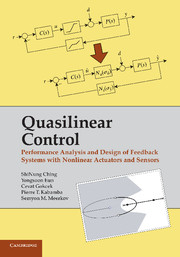 Quasilinear Control
Quasilinear Control Published online by Cambridge University Press: 01 June 2011
Motivation: This chapter is intended to introduce the class of systems addressed in this volume – the so-called Linear Plant/Nonlinear Instrumentation (LPNI) systems – and to characterize the control methodology developed in this book – Quasilinear Control (QLC).
Overview: After introducing the notions of LPNI systems and QLC and listing the problems addressed, the main technique of this book – the method of stochastic linearization – is briefly described and compared with the usual, Jacobian, linearization. In the framework of this comparison, it is shown that the former provides a more accurate description of LPNI systems than the latter, and the controllers designed using the QLC result, generically, yield better performance than those designed using linear control (LC). Finally, the content of the book is outlined.
Linear Plant/Nonlinear Instrumentation Systems and Quasilinear Control
Every control system contains nonlinear instrumentation – actuators and sensors. Indeed, the actuators are ubiquitously saturating; the sensors are often quantized; deadzone, friction, hysteresis, and so on are also encountered in actuator and sensor behavior.
Typically, the plants in control systems are nonlinear as well. However, if a control system operates effectively, that is, maintains its operation in a desired regime, the plant may be linearized and viewed as locally linear. The instrumentation, however, can not: to reject large disturbances, to respond to initial conditions sufficiently far away from the operating point, or to track large changes in reference signals – all may activate essential nonlinearities in actuators and sensors, resulting in fundamentally nonlinear behavior.
To save this book to your Kindle, first ensure [email protected] is added to your Approved Personal Document E-mail List under your Personal Document Settings on the Manage Your Content and Devices page of your Amazon account. Then enter the ‘name’ part of your Kindle email address below. Find out more about saving to your Kindle.
Note you can select to save to either the @free.kindle.com or @kindle.com variations. ‘@free.kindle.com’ emails are free but can only be saved to your device when it is connected to wi-fi. ‘@kindle.com’ emails can be delivered even when you are not connected to wi-fi, but note that service fees apply.
Find out more about the Kindle Personal Document Service.
To save content items to your account, please confirm that you agree to abide by our usage policies. If this is the first time you use this feature, you will be asked to authorise Cambridge Core to connect with your account. Find out more about saving content to Dropbox.
To save content items to your account, please confirm that you agree to abide by our usage policies. If this is the first time you use this feature, you will be asked to authorise Cambridge Core to connect with your account. Find out more about saving content to Google Drive.